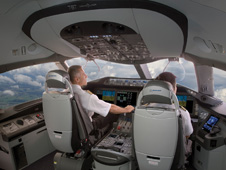Technology
Text Size
Changing Course to Faster Flights
 In the 1990s, scientists at Ames Research Center devised a software algorithm to shorten the routes airlines fly between take-off and landing. That technology is now commercially available from Boeing.
In the 1990s, scientists at Ames Research Center devised a software algorithm to shorten the routes airlines fly between take-off and landing. That technology is now commercially available from Boeing.› Link to larger photo
 Boeing’s Direct Routes service monitors flights in real time and checks for time savings. In this example, a flight saved 1.3 minutes by diverting from its original route to fly a more direct route.
Boeing’s Direct Routes service monitors flights in real time and checks for time savings. In this example, a flight saved 1.3 minutes by diverting from its original route to fly a more direct route.› Link to larger photo
A NASA tool cuts down on flight time, creating savings for pilots, passengers, and the environment.
Heinz Erzberger never thought the sky was falling, but he knew it could benefit from enhanced traffic control. For years, Erzberger led a team at NASA to develop technology that could improve the situation in the skies. One of the tools, a traffic management advisor, was adopted by the Federal Aviation Administration and implemented across the United States. Another tool—Direct-To—has followed a slightly different path.
The idea behind Direct-To, explains Erzberger, a senior scientist at NASA, was that airlines could save fuel and money by shortening the routes between take-off and landing. Erzberger came up with the idea of a software algorithm to automatically examine air traffic in real-time, check to see if a shortcut was available, and then ensure the shortcut created no conflicts.
His idea went from theory to practice when NASA demonstrated Direct-To in the airspace of Dallas-Ft. Worth in 2001. Estimates found the technology could save the aircraft flying in the test area 900 flying minutes per day.
NASA Technology: “A Great Jumpstart”
Interested in building on Erzberger’s work, Michael Lewis, director of Seattle-based Boeing Commercial Airplanes’ Airline Efficiency Services, met with Erzberger to discuss Direct-To.
Lewis was optimistic about transitioning the tool into a product that was practical for airlines to use. “We thought the NASA software would be a great jumpstart,” he says.
After signing a Space Act Agreement with NASA, Boeing licensed the technology and developed new software code on top of the core algorithms. To confirm the technology was practical for airlines, Boeing conducted trials with Southwest Airlines and Continental Airlines.
“The main result was that the operational concept really worked,” Lewis says.
As a result, Boeing incorporated the technology into a subscription-based product called Direct Routes that is now commercially available as part of the company’s InFlight Optimization Services.
Immediate Savings
According to Boeing, Direct Routes can save tens of thousands of flight minutes per year for a medium-sized US airline operator. In total, Lewis estimates the technology could save a total of 20 million gallons of fuel per year for commercial airlines, which is equivalent to more than $50 million in costs. These fuel savings also translate into a direct reduction of thousands of tons of carbon emissions annually.
Direct Routes continuously monitors flights in real time to check for traffic control system variables. When there are small course adjustments along an airplane’s intended route that can reduce at least 1 minute of flight time, the pilot is notified with a message much like a text message. The pilot can then make a verbal request to the controller who can approve the new route.
The advisories made by Direct Routes are transmitted using existing communication channels and are designed to comply with current operating procedures. “There’s a small amount of start-up and readiness preparation, but no capital investment on the part of the airlines. In general, if an airline starts the service, it starts seeing fuel savings immediately,” says Lewis.
Direct Routes is currently available as a subscription service to customers including commercial airlines, business aviation, military, general aviation, and international flights. “They all have opportunities to take shorter routes,” says Lewis. “Direct Routes is an ideal application of government investment plus some industry innovation. The result is real savings to airlines, passengers, and the environment.”
To learn more about this NASA spinoff, read the original article from Spinoff 2011.